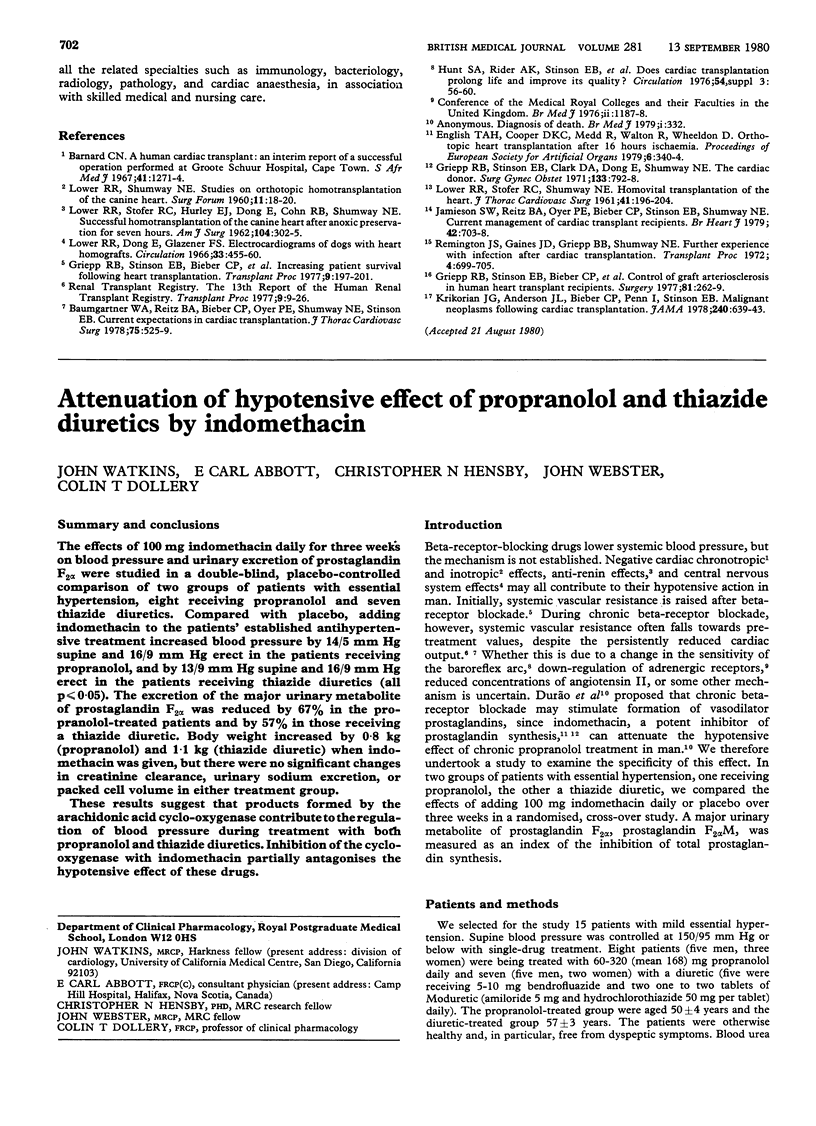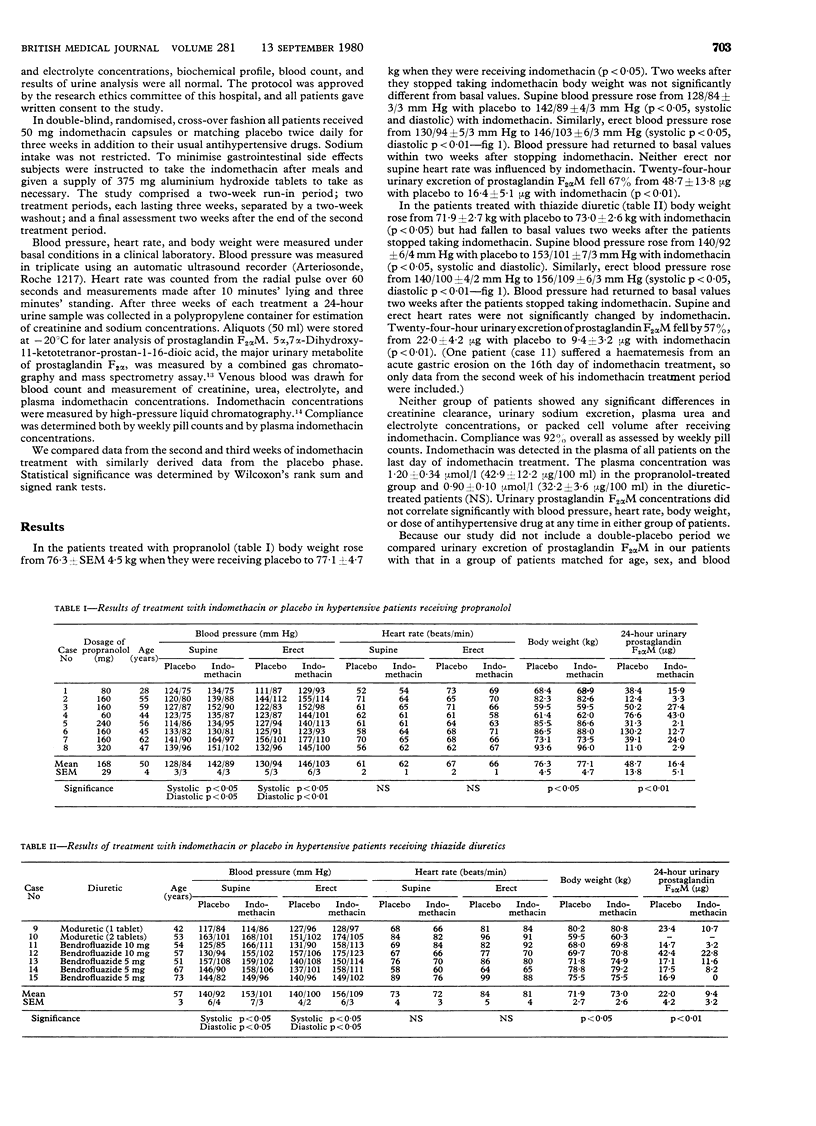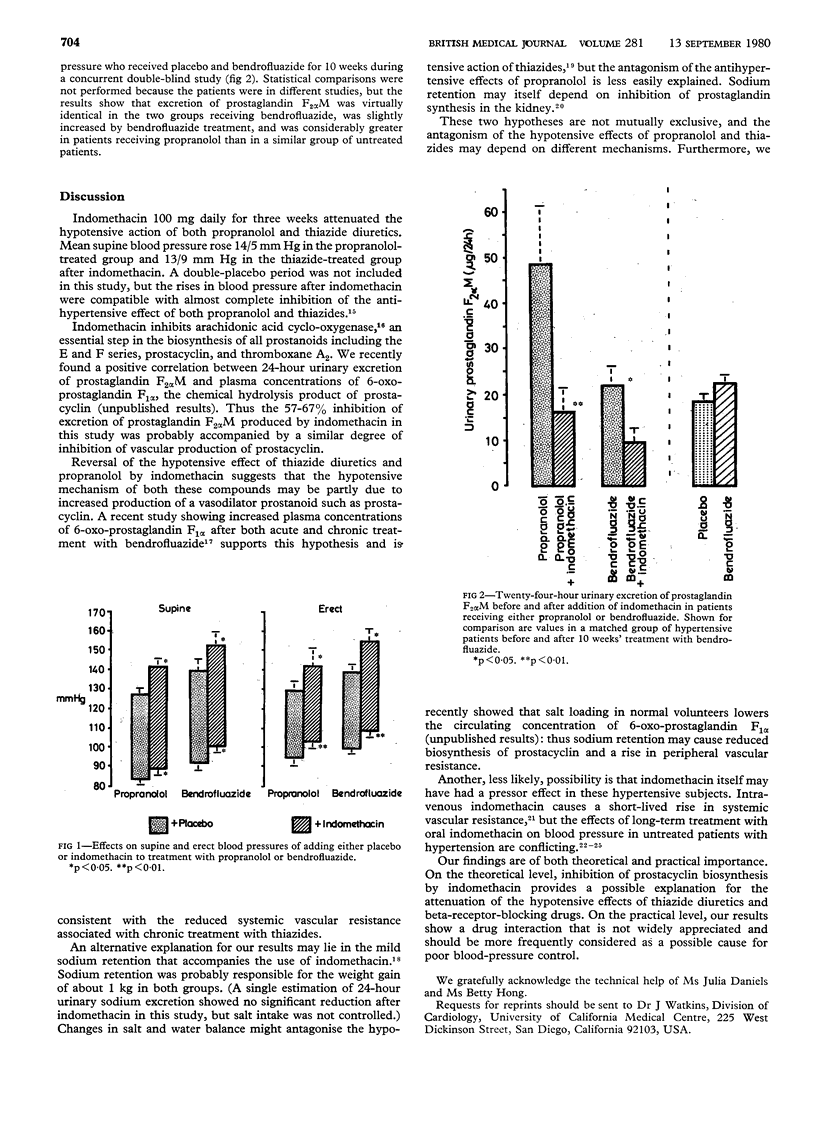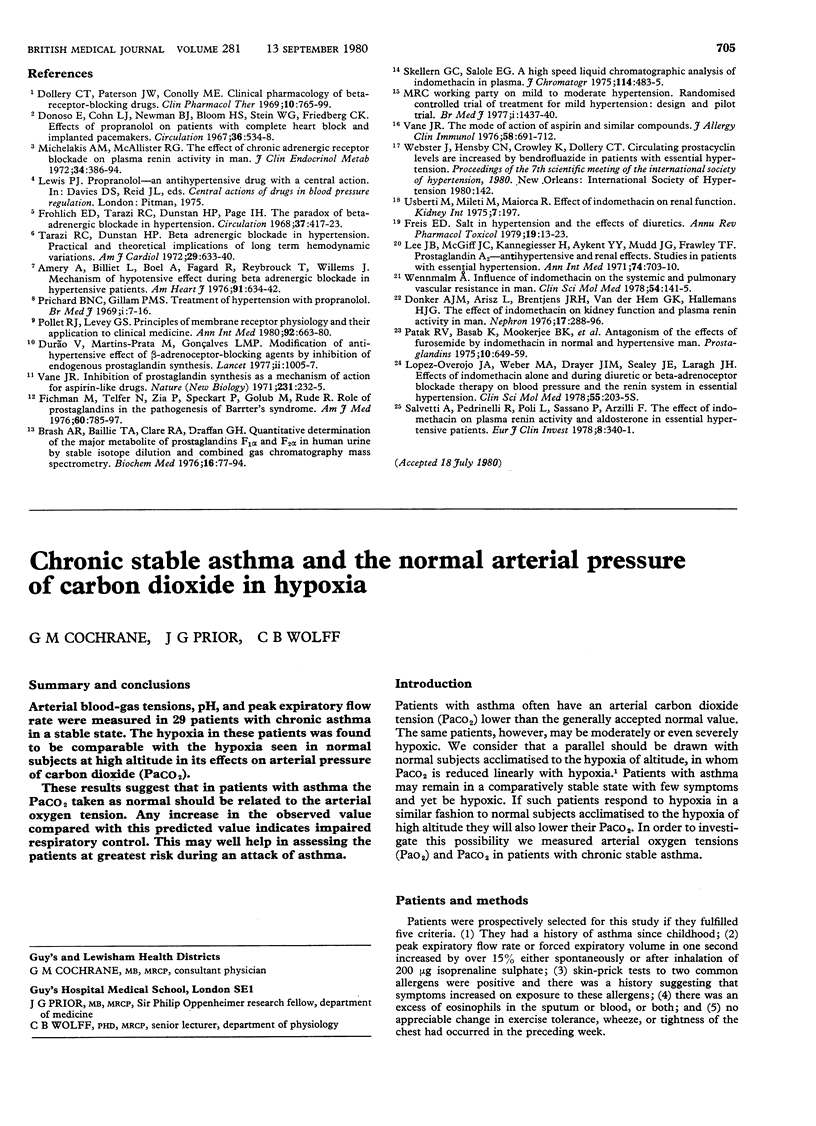Abstract
The effects of 100 mg indomethacin daily for three weeks on blood pressure and urinary excretion of prostaglandin F2 alpha were studied in a double-blind, placebo-controlled comparison of two groups of patients with essential hypertension, eight receiving propranolol and seven thiazide diuretics. Compared with placebo, adding indomethacin to the patients' established antihypertensive treatment increased blood pressure by 14/5 Hg supine and 16/9 mm Hg erect in the patients receiving propranolol, and by 13/9 mm Hg supine and 16/9 mm Hg erect in the patients receiving thiazide diuretics (all p less than or equal to 0.05). The excretion of the major urinary metabolite of prostaglandin F2 alpha was reduced by 67% in the propranolol-treated patients and by 57% in those receiving a thiazide diuretic. Body weight increased by 0 . 8 kg (propranolol) and 1 . 1 kg (thiazide diuretic) when indomethacin was given, but there were no significant changes in creatinine clearance, urinary sodium excretion, or packed cell volume in either treatment group. These results suggest that products formed by the arachidonic acid cyclo-oxygenase contribute to the regulation of blood pressure during treatment with both propranolol and thiazide diuretics. Inhibition of the cyclo-oxygenase with indomethacin partially antagonises the hypotensive effect of these drugs.
Full text
PDF



Selected References
These references are in PubMed. This may not be the complete list of references from this article.
- Amery A., Billiet L., Boel A., Fagard R., Reybrouck T., Willems J. Mechanism of hypotensive effect during betaadrenergic blockade in hypertensive patients. Am Heart J. 1976 May;91(5):634–642. doi: 10.1016/s0002-8703(76)80149-4. [DOI] [PubMed] [Google Scholar]
- Brash A. R., Baillie T. A., Clare R. A., Draffan G. H. Quantitative determination of the major metabolite of prostaglandins F1alpha and F2alpha in human urine by stable isotope dilution and combined gas chromatography--mass spectrometry. Biochem Med. 1976 Aug;16(1):77–94. doi: 10.1016/0006-2944(76)90011-9. [DOI] [PubMed] [Google Scholar]
- Dollery C. T., Paterson J. W., Conolly M. E. Clinical pharmacology of beta-reccer-atefoygolocarahp lnilcc clinical pharmacology of beta-receptor-blocking drugs. Clin Pharmacol Ther. 1969 Nov-Dec;10(6):765–799. [PubMed] [Google Scholar]
- Donker A. J., Arisz L., Brentjens J. R., van der Hem G. K., Hollemans H. J. The effect of indomethacin on kidney function and plasma renin activity in man. Nephron. 1976;17(4):288–296. doi: 10.1159/000180733. [DOI] [PubMed] [Google Scholar]
- Donoso E., Cohn L. J., Newman B. J., Bloom H. S., Stein W. G., Friedberg C. K. Effects of propranolol on patients with complete heart block and implanted pacemakers. Circulation. 1967 Oct;36(4):534–538. doi: 10.1161/01.cir.36.4.534. [DOI] [PubMed] [Google Scholar]
- Durão V., Prata M. M., Gonçalves L. M. Modification of antihypertensive effect of beta-adrenoceptor-blocking agents by inhibition of endogenous prostaglandin synthesis. Lancet. 1977 Nov 12;2(8046):1005–1007. doi: 10.1016/s0140-6736(77)92899-9. [DOI] [PubMed] [Google Scholar]
- Fichman M. P., Telfer N., Zia P., Speckart P., Golub M., Rude R. Role of prostaglandins in the pathogenesis of Bartter's syndrome. Am J Med. 1976 May 31;60(6):785–797. doi: 10.1016/0002-9343(76)90892-5. [DOI] [PubMed] [Google Scholar]
- Freis E. D. Salt in hypertension and the effects of diuretics. Annu Rev Pharmacol Toxicol. 1979;19:13–23. doi: 10.1146/annurev.pa.19.040179.000305. [DOI] [PubMed] [Google Scholar]
- Frohlich E. D., Tarazi R. C., Dustan H. P., Page I. H. The paradox of beta-adrenergic blockade in hypertension. Circulation. 1968 Mar;37(3):417–423. doi: 10.1161/01.cir.37.3.417. [DOI] [PubMed] [Google Scholar]
- Lee J. B., McGiff J. C., Kannegiesser H., Aykent Y. Y., Mudd J. G., Frawley T. F. Prostaglandin A1: antihypertensive and renal effects. Studies in patients with essential hypertension. Ann Intern Med. 1971 May;74(5):703–710. doi: 10.7326/0003-4819-74-5-703. [DOI] [PubMed] [Google Scholar]
- Michelakis A. M., McAllister R. G. The effect of chronic adrenergic receptor blockade on plasma renin activity in man. J Clin Endocrinol Metab. 1972 Feb;34(2):386–394. doi: 10.1210/jcem-34-2-386. [DOI] [PubMed] [Google Scholar]
- Patak R. V., Mookerjee B. K., Bentzel C. J., Hysert P. E., Babej M., Lee J. B. Antagonism of the effects of furosemide by indomethacin in normal and hypertensive man. Prostaglandins. 1975 Oct;10(4):649–659. doi: 10.1016/s0090-6980(75)80012-8. [DOI] [PubMed] [Google Scholar]
- Pollet R. J., Levey G. S. Principles of membrane receptor physiology and their application to clinical medicine. Ann Intern Med. 1980 May;92(5):663–680. doi: 10.7326/0003-4819-92-5-663. [DOI] [PubMed] [Google Scholar]
- Prichard B. N., Gillam P. M. Treatment of hypertension with propranolol. Br Med J. 1969 Jan 4;1(5635):7–16. doi: 10.1136/bmj.1.5635.7. [DOI] [PMC free article] [PubMed] [Google Scholar]
- Skellern G. G., Salole E. G. A high-speed liquid chromatographic analysis of indomethacin in plasma. J Chromatogr. 1975 Nov 26;114(2):483–485. doi: 10.1016/s0021-9673(01)92018-7. [DOI] [PubMed] [Google Scholar]
- Tarazi R. C., Dustan H. P. Beta adrenergic blockade in hypertension. Practical and theoretical implications of long-term hemodynamic variations. Am J Cardiol. 1972 May;29(5):633–640. doi: 10.1016/0002-9149(72)90164-6. [DOI] [PubMed] [Google Scholar]
- Vane J. R. The mode of action of aspirin and similar compounds. J Allergy Clin Immunol. 1976 Dec;58(6):691–712. doi: 10.1016/0091-6749(76)90181-0. [DOI] [PubMed] [Google Scholar]
- Wennmalm A. Influence of indomethacin on the systemic and pulmonary vascular resistance in man. Clin Sci Mol Med. 1978 Feb;54(2):141–145. doi: 10.1042/cs0540141. [DOI] [PubMed] [Google Scholar]


